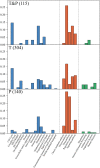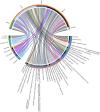Drug repositioning for dengue haemorrhagic fever by integrating multiple omics analyses
- PMID: 30679503
- PMCID: PMC6346040
- DOI: 10.1038/s41598-018-36636-1
Drug repositioning for dengue haemorrhagic fever by integrating multiple omics analyses
Abstract
To detect drug candidates for dengue haemorrhagic fever (DHF), we employed a computational drug repositioning method to perform an integrated multiple omics analysis based on transcriptomic, proteomic, and interactomic data. We identified 3,892 significant genes, 389 proteins, and 221 human proteins by transcriptomic analysis, proteomic analysis, and human-dengue virus protein-protein interactions, respectively. The drug candidates were selected using gene expression profiles for inverse drug-disease relationships compared with DHF patients and healthy controls as well as interactomic relationships between the signature proteins and chemical compounds. Integrating the results of the multiple omics analysis, we identified eight candidates for drug repositioning to treat DHF that targeted five proteins (ACTG1, CALR, ERC1, HSPA5, SYNE2) involved in human-dengue virus protein-protein interactions, and the signature proteins in the proteomic analysis mapped to significant pathways. Interestingly, five of these drug candidates, valparoic acid, sirolimus, resveratrol, vorinostat, and Y-27632, have been reported previously as effective treatments for flavivirus-induced diseases. The computational approach using multiple omics data for drug repositioning described in this study can be used effectively to identify novel drug candidates.
Conflict of interest statement
The authors declare no competing interests.
Figures









Similar articles
-
Application of multiple omics and network projection analyses to drug repositioning for pathogenic mosquito-borne viruses.Sci Rep. 2021 May 12;11(1):10136. doi: 10.1038/s41598-021-89171-x. Sci Rep. 2021. PMID: 33980888 Free PMC article.
-
Multi-Tissue Transcriptomic-Informed In Silico Investigation of Drugs for the Treatment of Dengue Fever Disease.Viruses. 2021 Aug 4;13(8):1540. doi: 10.3390/v13081540. Viruses. 2021. PMID: 34452405 Free PMC article.
-
Computational Drug-repositioning Approach Identifying Sirolimus as a Potential Therapeutic Option for Inflammatory Dilated Cardiomyopathy.Drug Res (Stuttg). 2019 Oct;69(10):565-571. doi: 10.1055/a-0950-9608. Epub 2019 Jun 25. Drug Res (Stuttg). 2019. PMID: 31238376
-
Drug repositioning in SLE: crowd-sourcing, literature-mining and Big Data analysis.Lupus. 2016 Sep;25(10):1150-70. doi: 10.1177/0961203316657437. Lupus. 2016. PMID: 27497259 Review.
-
A review of network-based approaches to drug repositioning.Brief Bioinform. 2018 Sep 28;19(5):878-892. doi: 10.1093/bib/bbx017. Brief Bioinform. 2018. PMID: 28334136 Review.
Cited by
-
Drug repositioning as a promising approach for the eradication of emerging and re-emerging viral agents.Mol Divers. 2025 Mar 18. doi: 10.1007/s11030-025-11131-8. Online ahead of print. Mol Divers. 2025. PMID: 40100484 Review.
-
Multi-platform omics analysis reveals molecular signature for COVID-19 pathogenesis, prognosis and drug target discovery.Signal Transduct Target Ther. 2021 Apr 15;6(1):155. doi: 10.1038/s41392-021-00508-4. Signal Transduct Target Ther. 2021. PMID: 33859163 Free PMC article.
-
Dengue Virus Non-Structural Protein 5 as a Versatile, Multi-Functional Effector in Host-Pathogen Interactions.Front Cell Infect Microbiol. 2021 Mar 18;11:574067. doi: 10.3389/fcimb.2021.574067. eCollection 2021. Front Cell Infect Microbiol. 2021. PMID: 33816326 Free PMC article. Review.
-
A medicinal chemistry perspective of drug repositioning: Recent advances and challenges in drug discovery.Eur J Med Chem. 2020 Jun 1;195:112275. doi: 10.1016/j.ejmech.2020.112275. Epub 2020 Apr 2. Eur J Med Chem. 2020. PMID: 32283298 Free PMC article. Review.
-
Multi-proteomic profiling of the varicella-zoster virus-host interface reveals host susceptibilities to severe infection.Nat Microbiol. 2025 Aug;10(8):2048-2072. doi: 10.1038/s41564-025-02068-7. Epub 2025 Jul 30. Nat Microbiol. 2025. PMID: 40739040 Free PMC article.
References
MeSH terms
LinkOut - more resources
Full Text Sources
Research Materials
Miscellaneous

